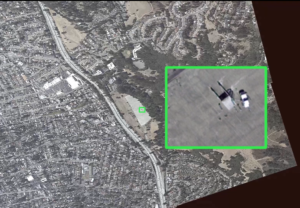Harris Corporation demonstrated its CorvusEye aerial surveillance system at the annual Urban Shield event organized by the Alameda County Sheriff’s Office in 2015. The aerial surveillance system was used as part of a water supply sabotage scenario at Dunsmuir Reservoir in Oakland.
The CorvusEye aerial surveillance system was developed by defense contractor Exelis, which Harris Corp. purchased in 2015. According to Harris’ web site, CorvusEye can provide continuous monitoring and tracking over a 2.7 square mile (7 square km) are during the day and 1.2 square miles (3.1 square km) at night.
Harris’ CorvusEye is a competitor to the system marketed by Persistent Surveillance Systems, which has been used to secretly monitor Baltimore and Compton, in Los Angeles County.
The surveillance footage provided by Harris Corp. to Urban Shield included Dunsmuir Reservoir, Interstate 580, Dunsmuir House and residential areas of Oakland and Sheffield Village. In an email dated September 9, 2015, a Harris Corporation marketing manager describes the video as “a live view of the reservoir showing 5 terrorists moving around on the reservoir.”
Click here for the video provided by Harris Corporation.
Harris also made a pitch for providing security for Super Bowl 50 at Levi’s Stadium:
Obviously, our team is interested in having CorvusEye help out with Super Bowl security. We’d love to sit down with him and his team to demo the footage we captured last month…is there any way you can make an introduction for us and perhaps set up quick 10-15 minute meeting to introduce him to CorvusEye?
A lieutenant from the Alameda County Sheriff’s Office responded with an offer of help:
I will do whatever I can to get you guys into the presentation on the Super Bowl. The folks from Santa Clara and Levi stadium will be at the VIP dinner Friday night. I will be there as well. Although I have not met these folks myself, let’s team up and track them down for a conversation! I have your back!
The details of how the CorvusEye surveillance systems works are explained in this video, produced by Exelis:
The annual Urban Shield event is an opportunity to introduce weapons, technology, and products developed for military and intelligence application to local law enforcement agencies.
Source material: Emails between Harris Corporation and Alameda County Sheriff’s Office
